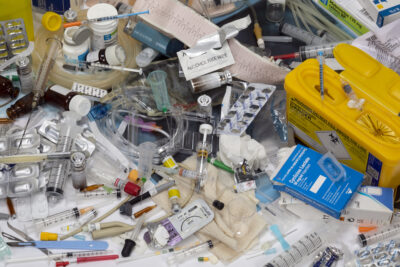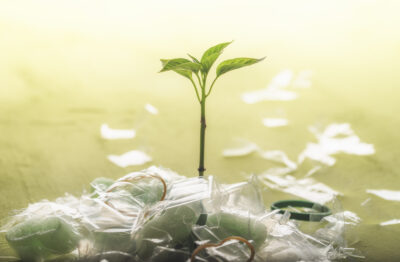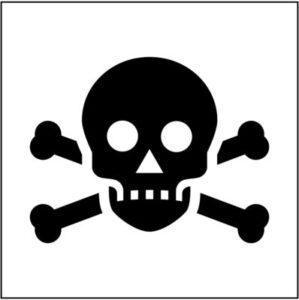Plastic: How is it possible to consider plastic a hazardous material? We drink out of plastic cups. We eat out of plastic plates. Much of our food is packaged in plastic.
In fact, it is hard to imagine living in a world without plastic. How can it be considered dangerous?
Hazardous Waste: Are You Guilty of Disposing of It Improperly?

Face Masks Are the New Public Litter.
Dispose of Medical and Biological Waste Properly.
Would you be surprised to discover you often throw hazardous plastic waste items right into your household trash? For example, your laptop or computer suddenly dies. What do you do with it? Most people simply put it in the garbage can. Do you bag it up and throw it away like any other trash? And yet, the EPA warns us, they list some parts of old computers as hazardous waste material.
Hazardous Waste: What is it?
Hazardous waste: It is one of those things we hear about all the time. Most of us probably believe it’s a radioactive material or maybe a corrosive chemical. And we are right up to a point.
Are you completely mystified when you try to discover what materials are hazardous? Well, you are not alone. The EPA (Environmental Protection Agency) partially defines “solid waste as a hazardous waste if it is specifically listed as a known hazardous waste or meets the characteristics of a hazardous waste.”
There are several categories of Hazardous Waste and a lengthy list in each category. The number alone reveals the staggering size of our planet’s hazardous plastic waste problem.
Hazardous Waste: Limiting the Scope
We, at Consolidated Waste Systems, realize the vastness of this problem cannot be dealt with in one blog. Therefore, we are limiting this blog to one topic that is of concern to individual families as well as industries in our communities: Hazardous plastic waste.
In future blogs, we will return our focus to Hazardous Waste, focusing on other materials and related topics.
At Consolidated Waste, we believe that our society can recycle and properly dispose of dangerous materials. We only need to give critically significant information to all of our communities.
Plastic: Both Hazardous and Non-hazardous
Plastic is a perfect example of a product that is both hazardous and safe for everyday use. Even though we live, eat and breathe with certain types, there are other categories that endanger our lives and the lives of all our neighbors and friends.
A Green Focus publication states that “Although it varies between types, every single category of plastic could become hazardous materials if put in an extreme situation such as extreme heat.”
The Threat of Hazardous Plastic: How Big Is It?

Life Will Find a Way, But Will It Include Us?
The danger of hazardous plastic involves several aspects including both the quality and quantity.
- The sheer volume or quantity of plastic waste is difficult to calculate.
- Did you know that some are so toxic that not even China will buy them from us for their thriving global waste industry? Consolidated Waste Systems has investigated several facts from the credible company, Seed Scientific. They offer you, our readers and friends, some fairly upsetting facts:
- The amount of plastic in the world exploded from 1.5 million tons in 1950 to 340 million tons in 2016.
- Over 300 million tons of plastic are produced every year.
- The world uses 500 billion single-use plastic bags every year.
- A plastic bag is used for only 15 minutes on average but can last for a millennium.
- About 269,000 tons of plastic waste floats in the ocean.
- Manufacturers admit that 91% of all the plastics ever created have not been recycled.
Islands of Plastic Hazardous Waste in Our Oceans:
While only a portion of plastic in the ocean is hazardous, the sheer quantity offers a serious threat to life in our oceans. For this reason, some experts believe all plastic should be considered hazardous. ABC News recently reported a unique geographic aspect of this hazardous threat: An actual island of plastic trash, floating in the Pacific Ocean.
Not a Tourist Attraction: “Great Pacific Garbage Patch”
They measured the Pacific island of hazardous plastic trash at “three times the area of France and more than twice the size of Texas.
- We have previously mentioned our concern. “It’s a massive island constructed entirely of trash and plastic. It is located between California and Hawaii.
- Additionally, researchers report this island to be growing rapidly. In fact, one study was published in Scientific Reports. And they created the name for it: the Great Pacific Garbage Patch.
- Furthermore, this is no small island. They estimated it “contains at least 79,000 tons discarded plastic.” The Ocean Cleanup project claimed that the patch covers 1.6 million square kilometers.
- Some of the plastic in the patch is over 50 years old. You might guess it includes souvenirs of 20th-century life: “plastic lighters, toothbrushes, water bottles, pens, baby bottles, cell phones, plastic bags, and nurdles (Small pieces of plastic.)” We are certain to report on “nurdles” in the future.
In addition to plastic, “small fibers of wood pulp found throughout the patch are “believed to originate from the thousands of tons of toilet paper flushed into the oceans daily.” (Ew!)
Additional Hazardous Threats

Every Generation Can Help Eliminate the Hazards of Plastic and Other Pollution.
The total hazard threat from plastic does not come from just the Pacific floating debris. The total quantity mentioned above does not include is a similar island in the Atlantic Ocean. Nor does it include debris buried in landfills and dumps all over the world.
ID Friends or Foes: 7 Different Types of Plastics?
Protect your life by knowing the 7 different types of plastic and their characteristics. Each category is described by a numbering system.
The Good, The Bad, and the Ugly: 7 Categories of Plastic
According to Green and Growing, the system uses numbers 1 to 7. You can find the numbers on the item package of any plastic item. The numbers are the ID of the particular category.
The Green and Growing organization states, “Look for it on the labels on the bottles, on the packaging of plastic medical devices…” Sometimes, you will find the ID engraved directly on the object.”
“By looking up the specific number, you can find information about the chemicals found in that item. Then, you will know that which of them are “highly toxic…”
Managing Hazardous Plastic
By knowing the main characteristics of each category, you will also know which type you can recycle. Additionally, you can choose those types that are less toxic and reduce the risks you are exposing yourself to.
Type 1 – PET
This abbreviation comes from polyethylene terephthalate. The PET category of hazardous waste represents a clear style of plastic. We use it for bottles, beverages, or food containers. Even if it’s not so widely known, the same material is present in cleaning containers that are everywhere around households.
Since they contain our food and drinks, they are pretty safe for us. However, burning them can release highly toxic fumes into the air. Remember to avoid reusing them. These plastics are porous. They might allow bacteria to pass through.
Type 2 – Easily Disposable and Eco-Friendly: HDPE
HDPE means high-density polyethylene. We agree with other experts that it is one of the most eco-friendly types of plastics in the known universe. You can tell it apart from PET because it is dense and opaque. We use it in containers for milk, juice, butter containers, and cleaning products. Did you know this is a type that is much preferred by recycling facilities?

Certain Plastics Are Our Friends and Some Are Not. So, Beware of Hazardous Plastics. They May Harm You As Well As Our Oceans.
Type 3 – Leaky and Toxic PVC
Polyvinyl chloride is widespread in widespread usage. We put it in pipes, inflatable products, plastic curtains, wraps. However, PVC might start leaking toxic chemicals when it is submitted to burning. PVC contains Phthalates. These substances escape the plastic and lead to a series of health issues.
Type 4 – Bagging Up the LDPE
Blame plastic bags for a preponderance of Low-density polyethylene throughout our society. Find it in plastics used for bags at grocery stores. However, it’s also a common food wrap, and manufacturers make bottles out of it. It’s somehow safe for humans, but it’s really difficult to recycle. Therefore, reuse such bags and bottles as often as possible.
Type 5 – PP for Prescriptions
You can find Polypropylene, or PP in medicine bottles, ketchup, and yogurt receptacles. Heat does not bother it. We use it to cook and store food. However, you might recognize it for being that material you can put in the microwave. It won’t degrade when exposed to heat.
However, be careful. It’s still better to take the food out of a plastic storage container and heat it in a different container. Remember, chemicals might leak with PP. It’s not toxic, but it is easy for you to recycle.
Type 6 – Polystyrene: Our Worst Case of Recyclability
Simply put, Polystyrene is Styrofoam. We package everything, including food within derivatives of this hazardous material.
On the one hand, if you heat it, it will start leaking extremely dangerous substances. On the other hand, recycling facilities usually don’t accept it. It is incredibly hard to recycle and throwing it away is even worse. The answer is simple: You or your business must avoid these types of plastics, and therefore, avoid a lot of damage.
Type 7 – All the Rest

Proper Plastic Waste Management Can Bring a New Dawn for Our Planet.
This is the broadest category, as it includes all the other types of plastics that don’t fit a definite group. Bioplastics, for instance, is one good example, as well as polycarbonate. Therefore, things are getting a little risky here. It’s hard to tell what these plastics contain, so we cannot know how harmful they are. Thank you for reading our blog. Stay safe and please return again and again.
Developing Story: From the Writer’s Desk
Next week we will take an investigative look at the ongoing epic power fail we call “The Texas Freeze,” and Winterizing Wind-Power. You won’t want to miss that still-unfolding story. As the ice thaws, the painful human story continues.

Would Winterizing Wind Turbines Have Curbed the Crash of the Texas Power-grid? Catch Next Week’s Report!


